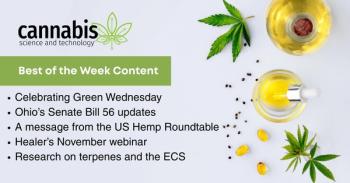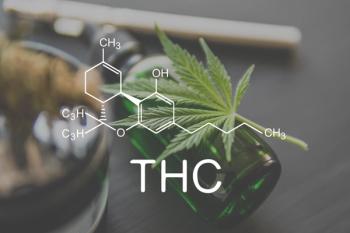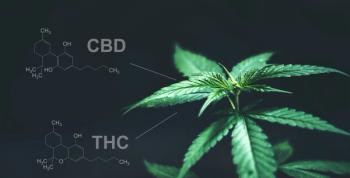
Cannabis Science and Technology
- October 2021
- Volume 4
- Issue 8
Measuring Cannabidiol Bioactivity: Neuronal Cell Survival and Neurite Outgrowth
This study presents bioassays for CBD, which can be used to assess the neurotrophic bioactivity of CBD formulations.
A significant endpoint to assess cannabidiol (CBD) preparations is bioactivity. Assessing CBD preparation bioactivity can be accomplished by measuring the biological effects of CBD on known biological pathways. CBD is known in various systems to promote neurite outgrowth and neuronal survival by acting through known neurotrophin signaling pathways. For example, CBD binds to the nerve growth factor (NGF) receptor known as TRKA and activates the extracellular-signal-regulated kinases 1 and 2 (ERK1/2) signaling pathway associated with NGF-induced neuronal cell survival and neurite outgrowth. Here we report the ability of CBD prepared by continuous extraction process with natural lipid-metabolites to activate signals through the TRKA-ERK1/2 pathway and promote survival and neurite outgrowth in neuronal PC12 cell cultures. PC12 cell viability and differentiation were measured over five days in glucose and serum deprived cultures treated with NGF or CBD. CBD enhanced PC12 cell survival above that seen with NGF by 15% on day three and 31% on day five. The ERK1/2 kinase inhibitor, K252a, inhibited both NGF and CBD induced survival and neurite outgrowth. Here we show that CBD acts like a neurotrophin by stimulating TRKA signaling and promoting neuronal cell viability and neurite outgrowth. Lastly, CBD prepared by continuous extraction process with natural lipid metabolites when combined with vitamin C-lipid metabolites showed the greatest cell survival and differentiation. The neurotrophic activity of CBD suggests that CBD may be useful in promoting survival of stem cell implants and also in cases when neuroplasticity contributes to healing such as in Parkinson’s disease, treatment of mood disorders, and nerve repair. This study presents bioassays for CBD, which can be used to assess the neurotrophic bioactivity of CBD formulations.
Neurotrophins are small soluble paracrine signaling molecules that promote neuronal cell survival, proliferation, and differentiation. These neurotrophins include nerve growth factor (NGF), brain derived neurotrophic factor (BDNF), neurotrophin–3 (NT-3), and glial-derived neurotrophic factor (GDNF). In addition to supporting the establishment of central nervous system (CNS) neurocircuitry, neurotrophins also support the survival of neuronal stem cell implants in animal models of spinal cord neuroregeneration and protect the CNS from toxicities and promote nerve repair and regeneration in the case of nerve damage (1–5). For example, both GDNF and NT3 have been shown to support the survival of neuronal stem cell implants in the CNS of animals and improve spinal cord repair (3-5). Further, in the absence of stem cells, the neurotrophins NGF, BDNF, and NT3 have all been shown to directly assist with neuritogenesis in the repair of spinal cord injury (5). Further, in cell culture systems, NGF promotes neuronal cell survival in an oxygen-glucose deprivation culture system (6) and promotes the survival of rat PC12 neuronal cell cultures in the presence of toxic levels of ethanol (2). Moreover, in humans, intraventricular injection of NGF into two children with hypoxic ischemic shock ameliorated the neuronal damage and promoted the restoration of neural networks (7). These neurotrophins affect neuronal survival and plasticity by binding to cell surface receptor tyrosine kinases and for NGF, BDNF, and NT-3 these receptors are known as the tropomyosin receptor kinase (TRK) A, B, and C, respectively, while GDNF binds to the cell surface tyrosine kinase receptor known as RET (rearranged during transfection) (8–10). Upon neurotrophin binding the TRKA-C and RET receptors trigger the activation of a variety of cytoplasmic kinases including the extracellular regulated kinases 1 and 2 (ERK1/2) which is associated with neuronal cell survival and neuritogenesis (11–18). Indeed, activation of the neurotrophin ERK1/2 signaling pathway is of great interest in the development of new neuroprotective and neuro-regenerative therapies (11,19,20). In this regard the therapeutic phytochemical, cannabidiol (CBD), acts like a neurotrophin and binds to the NGF receptor, TRKA, activates ERK1/2 promoting neurite outgrowth in PC12 neuronal cells, and protecting PC12 cells from ß-amyloid toxicity (21–23).
CBD is recognized by a wide range of cell receptor systems that are highly evolutionarily conserved and have a wide distribution in human body systems (24). Of particular note is the effect of CBD on the human nervous system with demonstrated benefits in treating pain, seizure, schizophrenia, addiction, anxiety, and Parkinson’s disease (25–31). In animal studies, CBD treatment has been shown to reduce brain damage in porcine and rodent models of neonatal hypoxia and ischemia (32,33) and in adult murine models of neurological ischemia (34,35). In neuronal cell culture systems, CBD has been shown to reduce ß-amyloid tau phosphorylation and subsequent toxicity to PC12 cells (21–23) and to reduce the toxicity of cadmium ion and hydrogen peroxide (36,37). Further, CBD binds to TRKA, activates ERK1/2 in rat and human neuronal cells (23,38), and promotes neurite outgrowth in PC12 cells (23). CBD promotes neurite outgrowth in both murine N2a neuronal cells and primary neurons and activates ERK1/2 through the cannabinoid receptor-1 (CB1) signaling (39,40). Overall, as noted, CBD is neurotrophic and possesses some of the therapeutic qualities of the neurotrophins.
Here, we use PC12 neuronal cell cultures to establish the conditions of assessing the neurotrophic activity of CBD. We tested the ability of CBD prepared by continuous extraction process with natural lipid-metabolites to act like NGF and promote neuronal cell survival and neurite outgrowth through the TRKA-ERK1/2 signaling pathway. We also tested the effect of adding citamin-C-lipid metabolites to the CBD treatment. Cell survival and viability was monitored by trypan blue exclusion and neurite outgrowth was assessed by visual inspection.
Materials and Methods
Cells and Reagents
PC12 cells were maintained in Dulbecco's Modified Eagle Medium (DMEM) containing 7.5% heat-inactivated horse serum and 7.5% fetal bovine serum (Fisher Scientific, Inc.) and cultured in T-75 vented Nunc brand tissue culture flasks (Fisher Scientific, Inc). For passage, PC12 cells were rinsed with serum-free DMEM and treated for 5–10 min with trypsin. Cells were then collected, suspended in culture medium, and plated at a 30% confluence. The PC12 cells were maintained between a 30% and 90% confluence in a CO2 water-jacketed incubator maintained at 37 oC. Murine 2.5 S nerve growth factor was purchased from Thermo Fisher Scientific, Inc., at a stock concentration of 100 µg/ml. K252a was purchased from Sigma Chemical Co. and dissolved in dimethyl sulfoxide (DMSO) to a stock concentration of 1 mg/mL and tested at 0.1 µM. CBD was prepared by continuous extraction process with natural lipid-metabolites (OneHemp CBD) and vitamin-C lipid metabolites (PureWay-C) were provided by One Innovation laboratories. High performance liquid chromatography (HPLC) analysis of the CBD preparations showed that both contained less than 0.015% THC while the CBD alone contained 3.12 mg/g of CBD, and the CBD with vitamin-C contained 2.79 mg/gm CBD. Both the CBD and CBD with vitamin-C preparations were emulsified into DMEM and tested at 10 µM. The vitamin-C was tested at 0.5 mM in combination with 10 µM CBD.
Neurite Outgrowth and Serum-Free Survival Assays
For both neurite outgrowth assays and serum-free survival assays, PC12 cells were collected and rinsed free of serum by centrifuging approximately 6x106 cells (a 90% confluent T-75 flask) pouring out the supernate and suspending the cells in DMEM and repeating this three times. For the final suspension the cells were placed in 1.0 mL DMEM and 10 µL of the cell suspension was counted on a heamocytometer. Cells were then diluted to 5x105 cells/mL of DMEM and 0.5 mL was seeded in the wells of a 24 well tissue culture plate (Fisher Scientific Inc.). At the time of cell seeding, for appropriate cells, NGF was added at a final 100 ng/mL concentration, K252a was added to appropriate wells at a final concentration of 0.1 µM, and CBD was added to appropriate wells at a final test concentration of 10 µM. Cells were immediately, and at various times, tested for viability by removing them, rinsing from test wells, and treating the cells with trypan blue and inspected at 10x magnification on a Heamocytometer. The medium collected prior to rinsing was also collected and the cells remaining attached to the wells were counted as a percentage of attached cells and then removed and combined with all cells from the well to count total cell viability. The percent viability was determined as the number of cells in a count of 100 that excluded the trypan blue. These cells were then discarded. To measure viability, cells were then collected on days 1, 3, and 5 to yield viability counts on days 0, 1, 3, and 5. Wells for assessment of neurite outgrowth were visually inspected and assessed for the percent of cells having a neurite extending at least one cell diameter. After assessment, these cells were returned to the incubator to continue the formation of neurite. The time course experiments were done in duplicate. Cells treated with K252a were separate experiments assessed on either day 3 or 5 and were done in triplicate.
Results and Discussion
To challenge the viability of PC12 cells, we removed from the culture media all glucose and serum proteins and factors and used trypan blue exclusion to determine PC12 cell culture viability over a 5-day period. In the absence of glucose and serum, cultures of PC12 lost viability by approximately 25% by day 3 and 70% by day 5 (Figure 1). Treatment with NGF protected PC12 cells from the catabolite and nutrient starvation condition with a 65% loss in viability by day 5. CBD treated cells showed the greatest protection with only a 45% loss in viability (Figure 1). These are the first data to show that NGF and CBD protected PC12 cells from glucose and serum starvation. In this regard, CBD may be an excellent treatment to include with stem cell implants to improve the survival of the implant. Further these data suggest that CBD treatment may also have neuroprotective value.
To explore the CBD signaling pathway involved in enhancement of PC12 cells survival, the ERK1/2 inhibitor K252a was added to the PC12 cell cultures. The ERK1/2 kinase inhibitor K252a blocked CBD-enhanced survival in PC12 cells (Figure 2). These are the first data to show that the ERK1/2 pathway enhanced PC12 cell viability when starved for glucose and serum.
PC12 cell morphology is polygonal and when treated with NGF these cells began to extend neurites (Figure 3). The maximum percentage of viable PC12 cells exhibiting neurite outgrowth on day 5 post treatment was approximately 25% (Figure 4). CBD stimulated neurite outgrowth approximately 35% greater than NGF. These data suggest that CBD may be a useful treatment in cases when neuroplasticity is required.
Vitamin C alone does not act as a neurotrophin, but it has been shown to potentiate NGF-mediated neurite outgrowth (41,42) (Table I). Here we tested to determine if vitamin-C would potentiate CBD-induced neuritogenesis. Indeed, when vitamin-C combined with CBD, the signaling was promoted to a greater extent than that seen with NGF (Table I). These data suggest that vitamin C may enhance the biological activity of CBD when prepared by continuous lipid extraction.
Conclusions
The bioactivity of CBD preparations, formulations, and mixtures is an important endpoint when CBD is considered for human health applications. For example, when applying CBD to the treatment of mood disorders, epilepsy, pain, and other neurologically related health issues, the ability of CBD to act on neurotrophin receptors and promote neuronal differentiation and survival is a valuable endpoint activity to measure and confirm. Here we find that when CBD is prepared by a continuous extraction process with natural lipid-metabolites (OneHemp CBD), it was neuroprotective and stimulated neurite outgrowth through the NGF ERK1/2 signaling pathway in PC12 cells. Furthermore, vitamin-C lipid metabolites (PureWay-C) potentiated certain cellular effects of CBD. Taken together this study presents useful bioassays to confirm the appropriate neurotrophic bioactivity of CBD preparations, formulations, and mixtures.
Acknowledgements
The funding to support this publication were provided by a grant from One Innovation Labs in Coral Gables, Florida to Benjamin S. Weeks at Adelphi University, Garden City, New York.
References
- M.V. Sofroniew, C.L. Howe, and W.C. Mobley, Annu Rev Neurosci. 24, 1217-1281 (2001).
- L. Liu, T. Sun, F. Xin, W. Cui, J. Guo, and J. Hu, Alcohol and Alcoholism 52(1), 12-18 (2017).
- S. Pan, Z. Qi, Q. Li, Y. Ma, C. Fu, S. Zheng, W. Kong, Q. Liu, and X. Yang, Artif. Cells Nanomed. Biotechnol. 47(1), 651-664 (2019).
- J.M. Wang, Y.S. Zeng, J.L. Wu, Y. Li, and Y.D. Teng, Biomaterials. 32(30), 7454-68 (2011).
- K.M. Keefe, I.S. Sheikh, and G.M. Smith, Int J Mol Sci. 18(3), 548 (2017).
- R. Tabakman, H. Jiang, I. Shahar, H. Arien-Zakay, R.A. Levine, and P.A. Lazarovici, NY Acad Sci. 1053, 84-96 (2005).
- C. Fantacci, D. Capozzi, P. Ferrara, and A. Chiaretti, Brain Sci. 3(3), 1013-1022 (2013).
- E. Scott-Solomon and R. Kuruvilla, Mol. Cell Neurosci. 91, 25-33 (2018).
- K. Kawai and M. Takahashi, Cell Tissue Res. 382(1), 113-123 (2020).
- A.K. Mahato and Y.A. Sidorova, Cell Tissue Res. 382(1), 147-160 (2020).
- B. Hausott and L. Klimaschewski, Anat Rec (Hoboken). 302(8), 1261-1267 (2019).
- W. Li, D. Wei, and J. Lin, et al. Front Cell Neurosci. 13, 351 (2019).
- R.M. Soler, X. Dolcet, M. Encinas, J. Egea, J.R. Bayascas, and J.X. Comella, J Neurosci. 19(21), 9160-9169 (1999).
- J.E. Cavanaugh, J. Ham, M. Hetman, S. Poser, C. Yan, and Z. Xia, J Neurosci. 21(2), 434-443 (2001).
- X. Hu, L. Jin, and L. Feng, J. Neurochem. 90(6), 1339-47 (2004).
- N. Lindgren, V. Francardo, L. Quintino, C. Lundberg, and M.A. Cenci, J. Parkinsons Dis. 2(4), 333-48 (2012).
- M. Alonso, J.H. Medina, and L. Pozzo-Miller, Learn Mem. 11(2), 172-178 (2004).
- J. Sun and G. Nan, Int. J. Mol. Med. 39(6), 1338-1346 (2017).
- V. Pernet, W.W. Hauswirth, and A. Di Polo, J. Neurochem. 93(1), 72-83 (2005).
- T. Liu, F.J. Cao, D.D. Xu, Y.Q. Xu, and S.Q. Feng, Neural. Regen. Res. 10(5), 792-6 (2015).
- G. Esposito, D. De Filippis, R. Carnuccio, A.A. Izzo, and T. Iuvone, J. Mol. Med. (Berl). 84(3), 253-8 (2006).
- T. Iuvone, G. Esposito, R. Esposito, R. Santamaria, M. Di Rosa, and A.A. Izzo, J. Neurochem. 89(1), 134-41 (2004).
- N.A. Santos, N.M. Martins, F.M. Sisti, L.S. Fernandes, R.S. Ferreira, R.H. Queiroz, and A.C. Santos, Toxicol. in Vitro. 30(1 Pt B), 231-40 (2015).
- S. Zou and U. Kumar, Int. J. Mol. Sci. 19(3), 833 (2018).
- B.S. Harvey, K.S. Ohlsson, J.L. Mååg, I.F. Musgrave, and S.D. Smid, Neurotoxicology 33(1), 138-46 (2012).
- G. Esposito, D. De Filippis, M.C. Maiuri, D. De Stefano, R. Carnuccio, and T. Iuvone, Neurosci. Lett. 399(1-2), 91-5 (2006).
- T. van de Donk, M. Niesters, M.A. Kowal, E. Olofsen, A. Dahan, and M. van Velzen, Pain 160(4), 860-869 (2019).
- A. Capano, R. Weaver, and E. Burkman, Postgrad. Med. 132(1), 56-61 (2020).
- M.H. Chagas, A.W. Zuardi, V. Tumas, M.A. Pena-Pereira, E.T. Sobreira, M.M. Bergamaschi, A.C. dos Santos, A.L. Teixeira, J.E. Hallak, and J.A. Crippa, J. Psychopharmacol. 11, 1088-98 (2014).
- H. Lafuente, F.J. Alvarez, M.R. Pazos, A. Alvarez, M.C. Rey-Santano, V. Mielgo, X. Murgia-Esteve, E. Hilario, and J. Martinez-Orgado, Pediatr. Res. 70(3), 272-7 (2011).
- F.J. Alvarez, H. Lafuente, M.C. Rey-Santano, V.E. Mielgo, E. Gastiasoro, M. Rueda, R.G. Pertwee, A.I. Castillo, J. Romero, and J. Martínez-Orgado, Pediatr. Res. 64(6), 653-8 (2008).
- M.R. Pazos, V. Cinquina, A. Gómez, R. Layunta, M. Santos, J. Fernández-Ruiz, and J. Martínez-Orgado, Neuropharmacology 63(5), 776-83 (2012).
- M. Ceprián, L. Jiménez-Sánchez, C. Vargas, L. Barata, W. Hind, and J. Martínez-Orgado, Neuropharmacology 116, 151-159 (2017).
- A.P. Schiavon, L.M. Soares, J.M. Bonato, H. Milani, F.S. Guimarães, and R.M. Weffort de Oliveira, Neurotox. Res. 26(4), 307-16 (2014).
- J. Fernández-Ruiz, O. Sagredo, M.R. Pazos, C. García, R. Pertwee, R. Mechoulam, and J. Martínez-Orgado, Br. J. Clin. Pharmacol. 75(2), 323-33 (2013).
- J.J.V. Branca, G. Morucci, M. Becatti, D. Carrino, C. Ghelardini, M. Gulisano, L. Di Cesare Mannelli, and A. Pacini, Int. J. Environ. Res. Public Health 16(22), 4420 (2019).
- J. Kim, J.Y. Choi, J. Seo, and I.S. Choi, Cannabis Cannabinoid Res. 6(1), 40-47 (2021).
- T.A.M. Vrechi, A.H.F.F. Leão, I.B.M. Morais, V.C. Abílio, A.W. Zuardi, J.E.C. Hallak, J.A. Crippa, C. Bincoletto, R.P. Ureshino, S.S. Smaili, and G.J.S. Pereira, Sci. Rep. 1, 5434 (2021).
- J.C. He, I. Gomes, T. Nguyen, G. Jayaram, P.T. Ram, L.A. Devi, and R. Iyengar, J. Biol. Chem. 280(39), 33426-34 (2005).
- S. Xapelli, F. Agasse, L. Sardà-Arroyo, L. Bernardino, T. Santos, F.F. Ribeiro, J. Valero, J. Bragança, C. Schitine, R.A. de Melo Reis, A.M. Sebastião, and J.O. Malva, PLoS One 8(5), e63529 (2013).
- B.S. Weeks and P.P. Perez, Med. Sci Monit. 13(3), BR51-BR58 (2007).
- B.S. Weeks, S.D. Weeks, A. Kim, L. Kessler, and P.P. Perez, "Physiological and Cellular Targets of Neurotrophic Anxiolytic Phytochemicals in Food and Dietary Supplements" [Online First], IntechOpen, DOI: 10.5772/intechopen.97565. Available from:
https://www.intechopen.com/online-first/physiological-and-cellular-targets-of-neurotrophic-anxiolytic-phytochemicals-in-food-and-dietary-sup .
About the Authors
BENJAMIN S. WEEKS is with the Department of Biology and Environmental Studies Program at Adelphi University in Garden City, New York. PEDRO P. PEREZ is with One Innovations Labs in Coral Gables, Florida. Direct correspondence to:
How to Cite this Article
B. S. Weeks and P. P. Perez, Cannabis Science and Technology 4(8), 46-56 (2021).
Articles in this issue
about 4 years ago
Cultivation Breakthroughs for a More Uniform Plant Are Comingabout 4 years ago
The Rise of In-line Color Remediationabout 4 years ago
Exploring the Impact of Cannabis on the Human Brain, Heart, and GutNewsletter
Unlock the latest breakthroughs in cannabis science—subscribe now to get expert insights, research, and industry updates delivered to your inbox.





